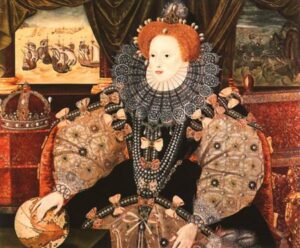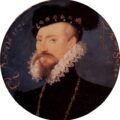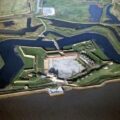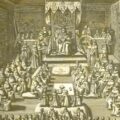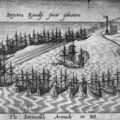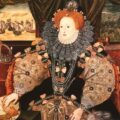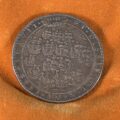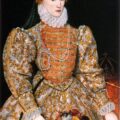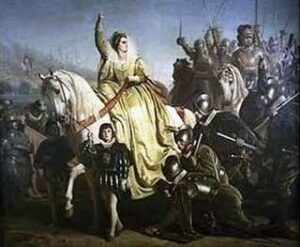
In her article “The Myth of Elizabeth at Tilbury”, Susan Frye, writes that there are no reliable eye-witness accounts regarding Elizabeth I’s appearance on that day, but that tradition places the Queen in armour, giving a rousing speech – an iconic Gloriana.
Descriptions of Elizabeth I at Tilbury
Many historians and authors have described Elizabeth I on that August day in 1588:-
In “Elizabeth the Great” (1958), Elizabeth Jenkins wrote:-
“A steel corselet was found for her to wear and a helmet with white plumes was given to a page to carry. Bareheaded, the Queen mounted the white horse. The Earl of Ormonde carried the sword of state before her, Leicester walked at the horse’s bridle, and the page with the helmet came behind.”
Carolly Erickson, in “The First Elizabeth” (1983), wrote:-
“She rode through their ranks on a huge white warhorse, armed like a queen out of antique mythology in a silver cuirass and silver truncheon. Her gown was white velvet, and there were plumes in her hair like those that waved from the helmets of the mounted soldiers.”
J E Neale, in “Queen Elizabeth I: A Biography” (1934), wrote:-
“Mounted on a stately steed, with a truncheon in her hands, she witnessed a mimic battle and afterwards reviewed the army.”
In “The Armada” (1959), Garrett Mattingly wrote:-
“She was clad all in white velvet with a silver cuirass embossed with a mythological design, and bore in her right hand a silver truncheon chased in gold.”
Reading those descriptions, it is clear, as Susan Frye points out, that an analogy is being drawn between Elizabeth I and Britomart, the armed heroine of Edmund Spenser’s “The Faerie Queene”, the virgin Knight of Chastity and Virtue. However there is no firm evidence that Elizabeth dressed like that on that day, but I like to think, with Elizabeth’s love of drama and her belief in the power of image and propaganda, that she appeared before her troops just like that.
The Tilbury Speech
There are three versions of the speech that Elizabeth I gave to the troops at Tilbury. The first is recorded by Dr Leonel Sharp in a letter to the Duke of Buckingham, thought to have been written sometime after the Duke of Buckingham’s 1623 marriage expedition to Spain. Sharp’s is the most famous rendition of Elizabeth I’s speech:-
“My loving people,
We have been persuaded by some that are careful of our safety, to take heed how we commit our selves to armed multitudes, for fear of treachery; but I assure you I do not desire to live to distrust my faithful and loving people. Let tyrants fear. I have always so behaved myself that, under God, I have placed my chiefest strength and safeguard in the loyal hearts and good-will of my subjects; and therefore I am come amongst you, as you see, at this time, not for my recreation and disport, but being resolved, in the midst and heat of the battle, to live and die amongst you all; to lay down for my God, and for my kingdom, and my people, my honour and my blood, even in the dust.
I know I have the body but of a weak and feeble woman; but I have the heart and stomach of a king, and of a king of England too, and think foul scorn that Parma or Spain, or any prince of Europe, should dare to invade the borders of my realm; to which rather than any dishonour shall grow by me, I myself will take up arms, I myself will be your general, judge, and rewarder of every one of your virtues in the field.
I know already, for your forwardness you have deserved rewards and crowns; and We do assure you in the word of a prince, they shall be duly paid you. In the mean time, my lieutenant general shall be in my stead, than whom never prince commanded a more noble or worthy subject; not doubting but by your obedience to my general, by your concord in the camp, and your valour in the field, we shall shortly have a famous victory over those enemies of my God, of my kingdom, and of my people.”
The second version of the Tilbury Speech is one recorded in 1612 by William Leigh, in his sermon “Quene Elizabeth, Paraleld in Her Princely Vertues”, where he described Elizabeth appearing before her troops “with God in her heart, and a commaunding staffe in her hand” and saying the following:-
“Come on now, my companions at arms, and fellow soldiers, in the field, now for the Lord, for your Queen, and for the Kingdom. For what are these proud Philistines, that they should revile the host of the living God? I have been your Prince in peace, so will I be in war; neither will I bid you go and fight, but come and let us fight the battle of the Lord. The enemy perhaps may challenge my sex for that I am a woman, so may I likewise charge their mould for that they are but men, whose breath is in their nostrils, and if God do not charge England with the sins of England, little do I fear their force… Si deus nobiscum quis contra nos? (if God is with us, who can be against us?)”
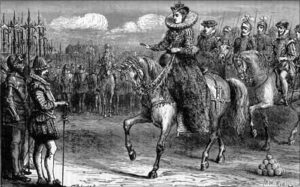
The third version of Elizabeth’s speech appears beneath the painting of “Elizabeth at Tilbury” in St Faith’s Church, Gaywood, which was commissioned by Thomas Hare (1572 – 1634), the rector and is dated 1588, although it may well have been painted in the early 16th century. This speech, published in Susan Frye’s article, reads:-
“Now for Queene & For the kingdome I have beene your Queene in
P[e]a[ce] in warre, neither will I bid you goe & Fight, but come &
let us Fight the battell of the Lorde-For what ar thes proud
Philistines that they should Revile the host of the Living God. It
may be they will challenge my [sexe] For that I am a woman so may
I charge [their] mo[uld] [flor that they ar but [men] whose breath is
in theire nostrells and if God doe not charge England with the
sinnes of England we shall not neede to feare what Rome or Spayne
can doe against us w: whome is but An ar[mi]e o[f] Flesh where as
with us in the Lord our God to Fight our battells & to helpe I with
us yt skills not Greatley if all the devills in hell be against us[.]”
Frye points out that this Gaywood speech and Leigh’s record of Elizabeth’s speech are scrambled versions of one another. Frye explains this:-
“If we delete the very different prayers with which the two versions end, and amend the text of the Gaywood speech as indicated in n. 16 [in note 16 of her article, Frye notes that the words “we commend your
prayers, for they will move the heavens, so doe wee your powerfull preaching, for that will shake
the earth of our earthly hearts; and call us to repentance, whereby our good God may relieve us,
and roote up in mercy his deferred Iudgements against us, onely be faithfull and fear not.” were excluded in the Leigh speech by her elipsis], then the Gaywood text, containing 122 words, reproduces 103 exact words of Leigh’s 147 words. Except for the lengthy Gaywood clause of 45 words (which explains why, if God does not hold England’s sins against her, no one need fear), most of the difference rests in alternate word choices: “I have beene your Queene in Peace” (Gaywood), “I have been your Prince in Peace” (Leigh); in paraphrase: “It may be they will challenge my [sexe]” (Gaywood), “the enemie perhaps may challenge my sexe” (Leigh); and in omission: “now for Queene & For the Kingdome” (Gaywood), “now for the Lord, for your
Queene and for the kingdome” (Leigh).”
Frye goes on to say that the Leigh and Gaywood speeches differ enough for the Gaywood painting speech to be a copy of Leigh’s sermon, but it could well be that they are derived from Elizabeth I’s actual speech. Frye is convinced that Leigh’s speech is “a more probable Tilbury speech, while Sharp’s may be a memorial reconstruction (he was at Tilbury)” and although Sharp was present at Tilbury, he was using the wording of the speech to make a point (he feared the proposed Spanish marriage of Prince Charles) so his version could be unreliable as it is coloured by his views. There are, however, similarities between the Leigh/Gaywood version and Sharp’s version, which Frye points out:-
- Military comradery – “my companion at arms” (Leigh) and “I myself will take up arms” (Sharp).
- Elizabeth plays on her sex -“the enemie perhaps may challenge my sexe” (Leigh) and “I have the body of weak and feeble woman.” (Sharp).
Tilbury and the Virgin Queen
Do the exact details of what Elizabeth wore at Tilbury and what she really said matter? Frye argues that:-
“For no matter what happened at Tilbury, no matter what the Queen wore or said, the fictions that surround her visit became essential. Contemporaries invented a first myth as the means to connect the defeat of the Armada with the Queen’s person through her virginity. Historians and biographers perpetuated a second myth, which portrayed Elizabeth as symbolic of England’s emergent military power and, by extension, of a unified political power she did not actually command.”
and she also goes on to say that this image and mythology of Elizabeth as the Virgin Queen, whose “virtue was closely associated with the welfare of England throughout her reign”, meant that an attack on England actually constituted rape, because it was an attack on Elizabeth’s person. She talks about Louis Montrose’s discussion on the Armada Portrait and how the defeat of the Spanish Armada was “expressed in sexual terms”:-
“The Armada portrait-or, more precisely, the three extant Armada portraits, for they are nearly identical-makes a clear spatial connection in the triangle linking the two pictures of an Armada beset by
storms and fireships with the virginal bow at the end of Elizabeth’s stomacher, to which our eyes are drawn by strands of virginal pearls and rows of tight, small bows.”
Interesting!
Although I knew that the painting was referring to Elizabeth as the Virgin Queen, I had never thought about the Spanish attack being seen as rape. Elizabeth saw herself as a virgin married to England, so an attack on the country was an attack on her and her virginity.
Reality
Susan Frye points out that England was definitely on the defensive during the Spanish Armada and ill prepared for an English invasion. Spain had been preparing its Armada for three years, yet England’s lack of financial credit meant that Elizabeth’s Privy Council could only take defensive measures at the last moment, e.g. the Earl of Leicester amassing troops at Tilbury in late July and early August 1588 when the Armada were already in the Channel. It is fortunate that England made good use of its lighter ships, which were easy to manoeuvre, that it had Effingham and Drake to command its fleet and that the weather (the Protestant Wind) worked against the Armada.
Susan Frye writes:-
“To those alive in 1588, England must have seemed anything but united, just as Elizabeth’s Tilbury visit may have only provided ineffectual pageantry, for she performed before unpaid and illequipped and even hungry soldiers, many of whom, we know from royal proclamation, tried to sell their armor the moment they were disbanded. Nevertheless, the Queen’s review of the troops proved a brilliant stroke, which grew more brilliant in the succeeding weeks, years, and centuries because it provided a moment through which generations could cast Elizabeth I as the powerful political icon she remains.”
and I think she has hit the nail on the head. Elizabeth’s visit to the troops was essential to raise morale and as propaganda. Elizabeth knew just what she was doing!
Elizabeth’s understanding of the importance of image has led to us, over 400 years later, still regarding her as the Virgin Queen and Gloriana, the monarch who brought a Golden Age to England. How powerful is that?!
Notes and Sources
- “The Myth of Elizabeth at Tilbury” by Susan Frye from “The Sixteenth Century Journal”, Vol.23, No.1, Spring 1992, p95-114, found at JSTOR
